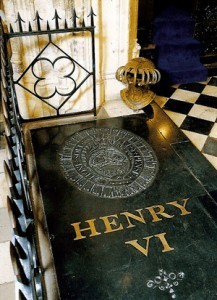
Henry VI’s resting place at Windsor. But maybe not for long . . .
Over the last few weeks, the topic of where Richard III (if the remains at Leicester prove to be his) should be reburied has been the subject of intense (and rather emotional) debate, centering around where the king would have preferred to have been buried. My modest proposal on Facebook that he be divided up in truly medieval style–one quarter at Leicester, one quarter at York, one quarter at Fotheringhay, one quarter at Westminister, and the head awarded to the highest-bidding Ricardian–was, sadly, not heeded by the authorities, so the debate still rages.
It will not be until December, as I understand, that the testing on the remains at Leicester will be completed, so there’s plenty of time to determine where the presumed Richard III will have his final resting place. So in the meantime, why not offer another candidate for reburial? Ladies and gentlemen, I give you Henry VI.
(First, you might say that as an American, it is really none of my business where the British government buries its dead monarchs. I beg to differ. As an American, it is my First Amendment right to express an opinion on anything I want. So sit back and drink your tea and listen.)
Henry VI, in case you might have forgotten, died in the Tower, supposedly of “sheer displeasure and melancholy” but most likely with the assistance of an agent of Edward IV, on the evening of May 21, 1471, hours after the return of the triumphant Yorkist king to London. He was buried at Chertsey Abbey. Later, Richard III ordered that he be moved to St. George’s Chapel at Windsor, where he remains today.
Now, St. George’s Chapel is a perfectly respectable resting place for a former king, but it doesn’t seem to have been where Henry himself wanted to rest. According to later depositions, Henry went to Westminster Abbey in the presence of witnesses and scouted out possible burial spots, even going so far as to pace out the distance himself with “his own feet.” So since we know Henry wanted to be buried at Westminster, why shouldn’t we right this centuries-old wrong and put the man in his preferred resting spot?
In fact, I think it’s time the entire Lancastrian royal family was reunited. Prince Edward, Henry’s son, fell at the battle of Tewkesbury and was buried in the abbey there. He has been made to spend eternity staring up at the Yorkist emblem of the Sun in Splendor, which really seems unfair for the young man to have to go through. Oh, sure, it’s a beautiful abbey and all, and he has the Despensers and the Duke of Clarence to keep him company, but doesn’t a man’s feelings count for anything?
And what of Margaret of Anjou? Having lived her last years in obscurity, she was buried at Angers, where no trace of her tomb remains. It’s true that she asked in her will to be buried by her parents at Angers, but that’s before she realized that later generations might be so accommodating of her true last wishes. Let’s bring Margaret back to her menfolk!
And speaking of the Woodvilles (OK, we weren’t, but on this blog we always speak of the Woodvilles at some point), Anthony Woodville made it clear in his will that he wanted to be buried at Westminster, at least before he found out that he was to be executed at Pontefract. Since Richard didn’t bother to give him a proper trial in front of his peers, can’t we at least set things a little right by giving Anthony the burial of his dreams? (Especially if Richard himself gets to be moved to York.)
And speaking of the Tudors (because it’s always fun to speak of the Tudors), think of all those poor souls executed at the Tower, some on very dubious grounds. Imagine the excitement if Anne Boleyn was brought up and reburied! Maybe we could take her to Windsor, where Henry VIII is buried with Jane Seymour, just to irritate Great Harry. (After all, with Henry VI moved to Westminster, there will be some room at Windsor for Anne.)
So what are we waiting for? Let’s start digging!
 newest »
newest »
 newest »
newest »
 Great post Susan! I think the quartering idea for R3 is the best solution I've heard yet ;-).
Great post Susan! I think the quartering idea for R3 is the best solution I've heard yet ;-).
 So Richard would not have wanted to be buried at Westminster? Poor Margaret and Henry! They should at least be together with their son Prince Edward.
So Richard would not have wanted to be buried at Westminster? Poor Margaret and Henry! They should at least be together with their son Prince Edward.
 I would love to find the place whereAntony Woodville was buried. All we know is that, after the execution at Pontefract, he and his nephew Richard Grey and two others, were thrown, un coffined into a communal grave at a nearby monastery.
I would love to find the place whereAntony Woodville was buried. All we know is that, after the execution at Pontefract, he and his nephew Richard Grey and two others, were thrown, un coffined into a communal grave at a nearby monastery. 









